Bulletin – December 2012 India's Services Exports
- Download the article 205KB
Abstract
Exports of services are an important source of demand for the Indian economy and account for a larger share of output than in most major economies. The importance of India's services exports mirrors that of the broader services sector in India, which is large compared with other countries at a similar stage of development. This article provides an overview of India's services exports, focusing on their composition and destination, and discusses some of the reasons why services exports are so important to the Indian economy.
Introduction
Since the Indian balance of payments crisis in the early 1990s, India's services sector has increased substantially as a share of total output. This marked growth can be attributed to a series of reforms introduced by the Indian Government throughout the 1990s and early 2000s related to the services sector, including financial market deregulation and increased competition in a wide range of service industries. This growth coincided with strong productivity growth in the services sector (Gordon and Gupta 2003). In contrast, the manufacturing sector remains more heavily regulated, although the extent of this regulation has been reduced gradually over the past 20 years or so. To encourage investment in the services sector, the government introduced tax concessions and established special business zones. Furthermore, growth in some service industries was supported by foreign investment, particularly in the telecommunication and information technology & software (ITS) sectors. This was facilitated by the relaxation of regulations on foreign ownership in these sectors (Indicus Analytics 2005). As a result of these developments, India's services sector has expanded rapidly and now accounts for over 55 per cent of output – a much larger share than in other countries with similar levels of per capita income (Cagliarini and Baker 2010).
Consistent with the expansion in the services sector, India's services exports have grown rapidly over the past two decades (Graph 1). As services tend to be more labour intensive than manufacturing or mining, growth in services exports has also been supported by relatively cheap labour, a large tertiary-educated workforce and the fact that English is widely spoken, which give India an advantage when doing business with foreign companies from English-speaking economies. Over the past year, even as GDP growth has slowed, services exports from India have continued to expand strongly, in part aided by the boost to competitiveness from the depreciation of the rupee.
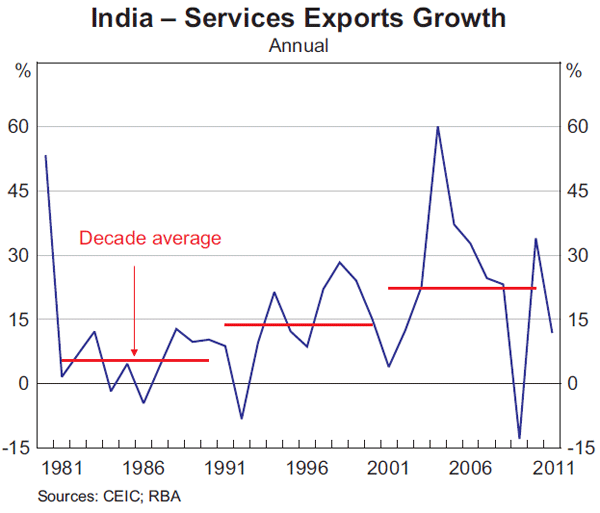
India's services exports accounted for 8 per cent of GDP in 2011 and for a relatively high share of total exports (Table 1). This is higher than in most advanced economies, the notable exceptions being South Korea – with a handful of large South Korean shipping companies making that country a major exporter of transport services – and the United Kingdom, whose services exports are boosted by its large financial sector. Elsewhere in Asia, Singapore's services exports are very large relative to the size of its economy, with services exports accounting for around 45 per cent of GDP. A large share of Singapore's services exports are travel and transport services, consistent with Singapore's role as a transit hub (for both passengers and freight). The Philippines' services exports are broadly similar to India's in terms of their importance for the overall economy, and both countries are exposed to ITS exports.
| Economy |
Services share of output(a) |
Services exports share of output |
Services exports share of total exports |
|---|---|---|---|
| Advanced economies | |||
| Australia | 69 | 3 | 16 |
| Euro area | 73 | 6 | 24 |
| Japan | 71 | 2 | 12 |
| Singapore | 73 | 44 | 21 |
| South Korea | 58 | 9 | 15 |
| United Kingdom | 77 | 13 | 40 |
| United States | 80 | 4 | 29 |
| Emerging economies | |||
| India | 56 | 8 | 30 |
| Brazil | 57 | 2 | 13 |
| China | 43 | 3 | 9 |
| Indonesia | 38 | 2 | 8 |
| Pakistan | 54 | 3 | 19 |
| Philippines | 56 | 7 | 25 |
|
(a) Services output is defined as total gross value added less gross value added in agriculture, forestry & fishing; mining; manufacturing; electricity, gas, water and waste services; and construction industries Sources: ABS; CEIC; IMF; Office for National Statistics; Thomson Reuters; World Bank |
|||
India's services imports are relatively small, at around 4¼ per cent of GDP in 2011, with business services, travel and transportation services accounting for more than 70 per cent of total services imports. Accordingly, India has a surplus in its services trade. While this surplus has been expanding over the past decade, the current account deficit has been widening, driven by India's growing merchandise trade deficit (Graph 2).

Components of Services Exports
The ITS sector is the largest and one of the fastest growing services exporting sectors of the Indian economy; over the past 15 years, the value of ITS services exports has grown at an average annual rate of almost 30 per cent (Graph 3). The ITS sector is also predominantly export oriented, with exports accounting for around two-thirds of its revenue (NASSCOM 2011). The rapid growth in ITS exports has resulted in the sector's share of total services exports rising from less than 20 per cent in 1997/98 to around 45 per cent in the 2011/12 fiscal year.[1]
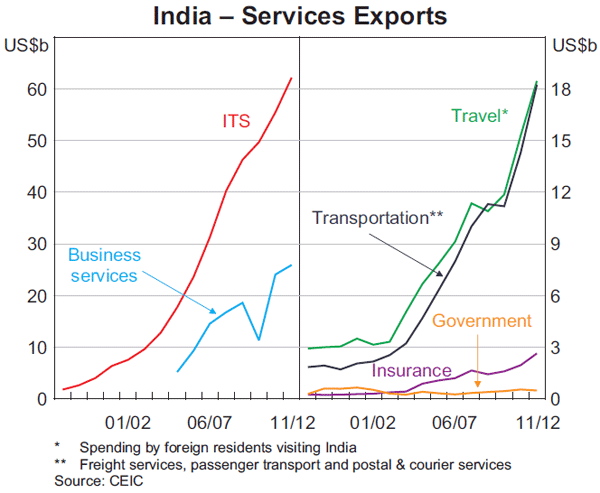
The ITS sector can be divided into three broad industries: information technology, business process outsourcing and engineering design & product development. The exports of all of these industries have grown rapidly in recent years, though growth rates slowed in 2009/10, with depressed global economic conditions resulting in a softening in demand for information services, particularly from the advanced economies (Graph 4). Since 2010, growth in ITS exports has picked up again as economic conditions in some advanced economies have improved.
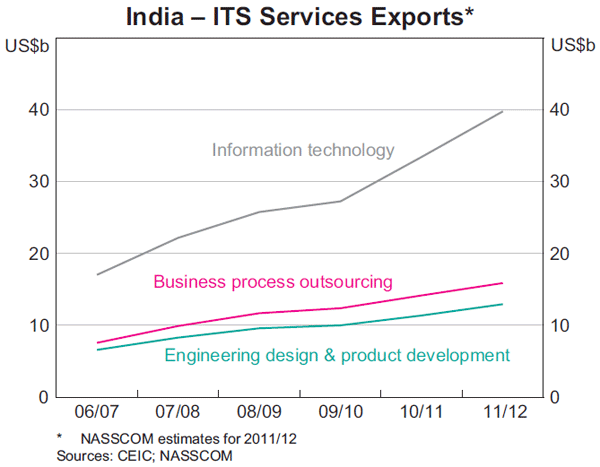
A common misconception is that a large share of India's services exports are call centre-related services. However, business process outsourcing, which includes call centre-related services, only represents around one-quarter of total ITS exports. In fact, more than half of India's ITS export revenue comes from information technology exports, which include consulting, system integration and management.
Nonetheless, business process outsourcing is still an important source of export revenue, accounting for around 10 per cent of India's total services exports revenue in 2011. ‘Customer interaction’ exports (which include call centres) is the largest component of business process outsourcing, making up around one-third of the category (Graph 5). Other business process outsourcing activities include ‘finance & accounting’, which covers services such as account keeping and statutory reporting; ‘knowledge services’, which refers to outsourcing of functions such as business research and data management; and specialised and vertically integrated services, sometimes referred as ‘verticals’, which require a high level of knowledge about the client industry (such as medical transcription and processing of mortgage and credit card applications).
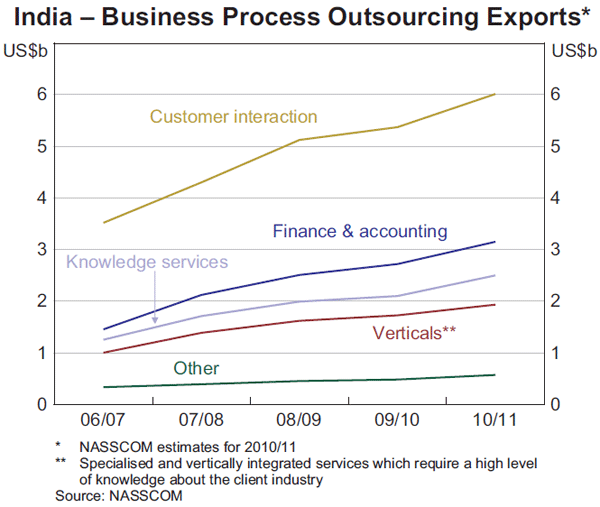
As discussed above, India has a substantial competitive advantage in delivering such services and this explains why advanced economies tend to import ITS services from India. According to NASSCOM (2011), the average operating cost per full-time employee in India can be up to 80 per cent lower than in the United States[2] In addition, labour costs in India are low relative to those of potential regional competitors such as Malaysia and the Philippines (NASSCOM 2011). Many large multinational firms have established bases in India to take advantage of these lower costs.
Services exports from most other major sectors of the economy have grown at a slower pace than ITS exports over the past decade and as a result, the share of total services exports has declined for these sectors. Nevertheless, growth in non-ITS services exports has been strong. Over the past decade, transportation exports – namely freight services, passenger transport and postal & courier services – grew by more than 20 per cent per year, while travel exports (spending by foreign residents visiting India) grew by around 20 per cent per year. Rapid growth in travel exports is consistent with a sharp increase in tourist arrivals, which have more than doubled over the past decade (Graph 6). This period of rapid growth was preceded by the announcement of the second National Tourism Policy, which called for faster processing of tourism visas and identified the need for more effective marketing in order for India to differentiate itself from other destinations (Ministry of Tourism 2002). The global ‘Incredible India’ advertising campaign was launched shortly after the announcement of the policy and is likely to have contributed to the strong growth in India's tourism in the subsequent decade.
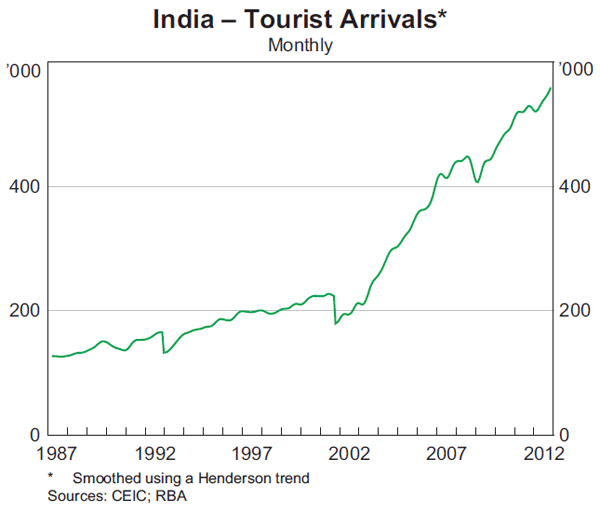
Destination of Exports
There is no detailed breakdown of India's services trade by country. However, as cheap labour costs and English language skills have been some of the key drivers of the expansion in ITS and services exports, it would seem likely that a large share of these exports are to advanced economies, particularly those where English is spoken. Surprisingly, data for advanced economies suggest that their services imports from India account for only a relatively small share of India's total services exports. Services imports originating from India and imported by the United States, euro area and the United Kingdom together account for only around one-fifth of India's total services exports. It is possible that this low share reflects difficulties that statisticians face in identifying the source country for services imports.
Alternative data sources suggest that, at least for certain types of services exports, the advanced economies are indeed important trading partners for India. According to DeitY (2010), over 90 per cent of India's ITS services exports in 2007/08 were destined for Europe and the Americas. Also, data on visitor arrivals into India can be used to provide a breakdown of travel services exports by country. In 2010, around 30 per cent of India's visitors arrived from Western Europe, 20 per cent from North America and 20 per cent from south Asia, indicating that these regions are important destinations for India's travel services exports (Table 2).
| Origin | 2000 | 2010 | ||
|---|---|---|---|---|
| Arrivals | Share of total | Arrivals | Share of total | |
| ‘000s | Per cent | ‘000s | Per cent | |
| Western Europe | 810 | 31 | 1,750 | 30 |
| North America | 408 | 15 | 1,174 | 20 |
| South Asia | 645 | 24 | 1,047 | 18 |
| East Asia | 275 | 13 | 851 | 15 |
| China | 8 | 0 | 120 | 2 |
| Australia | 90 | 3 | 170 | 3 |
| Rest of the world | 421 | 13 | 783 | 14 |
| Total(a) | 2,649 | 100 | 5,776 | 100 |
|
(a) Arrivals and shares may not sum to totals due to rounding Sources: CEIC; RBA |
||||
Conclusion
India's services exports have grown strongly over the past two decades, aided by a combination of less regulation relative to other sectors of the Indian economy, the widespread English language skills of the populace, and lower labour and other operating costs compared with those in advanced economies. Services exports now account for a relatively large share of India's economy, mirroring the large share of the broader services sector in India's GDP. India is likely to maintain its cost advantage in providing services into the foreseeable future, which suggests that the medium-term outlookfor its services exports is positive, though weak growth in the advanced economies could temper the rate of expansion in the near term.
References
Cagliarini A and M Baker (2010), ‘Economic Change in India’, RBA Bulletin, September, pp 19–24.
DeitY (Department of Electronics and Information Technology) (2010),‘Export Destinations’, statistical table, 27 March. Available at <http://deity.gov.in/content/export-destinations>.
Gordon J and P Gupta (2003), ‘Understanding India's Services Revolution’, Presentation to IMF-NCAER Conference ‘A Tale of Two Giants: India's and China's Experience with Reforms’, New Delhi, 14–16 November. Available at <http://www.imf.org/external/np/apd/seminars/2003/newdelhi/gordon.pdf>.
Indicus Analytics (2005), ‘Services Sector Reforms in India’, Research Report Submitted to the World Bank. Available at <http://www.indicus.net/Research/New_Database_website%5CWebsite_hierachy%5CStudies_Presentation%5CAll_Studies_list%5COthers%5CService_Sector_reforms%5CService_sector_reforms.pdf>.
Ministry of Tourism (Ministry of Tourism, Government of India) (2002), ‘National Tourism Policy’. Available at <http://www.tourism.gov.in/writereaddata/Uploaded/ImpDoc/071920111129103.pdf>.
NASSCOM (2011), ‘The IT-BPO Sector in India: Strategic Review 2011’, report. Available at <http://www.nasscom.in/ itbpo-sector-indiastrategic-review-2011>.